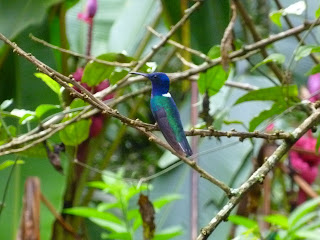 "Its easy to get into Parque Cajas" admonished Lucien when he learned our next destination. "But not so easy to get out." In truth, people have been navigating the high páramo of what is now Parque National Cajas for over three thousand years. Also true, the rolling labyrinth of glacial lakes and sudden appearance of fog, rain or sleet at any time of day makes navigation a challenge.
"Its easy to get into Parque Cajas" admonished Lucien when he learned our next destination. "But not so easy to get out." In truth, people have been navigating the high páramo of what is now Parque National Cajas for over three thousand years. Also true, the rolling labyrinth of glacial lakes and sudden appearance of fog, rain or sleet at any time of day makes navigation a challenge. But enter we did, climbing Loma Cucheros and descending to the Burin valley and Lago Ingañan. The rain came in early, and we sloshed down the trail in our rubber boots and full rain gear. At our feet flowers bloomed: the yellow orchid-like Halenia, purple gentians reminiscent of Siberian squill, and the centimeter-wide circus tents of Gentianella. At the laguna, a herd of five llamas cropped the páramo grasses, their long eye lashes and coats thick with moisture.
We climbed to a pass above the lake and camped on the cushion plants, the only reasonably dry and flat place the land offered. The first late-afternoon sun we’d encountered in weeks poured in under low clouds. It hit the landscape spinning gold from the grasses and setting the kettles and potholes of water to dancing. A carunculated caracara soared over our site, and we watched until gathering clouds sent us scrambling for the tent.
For the next two days, we followed the Inca road. The Inca stonework is still evident in places; bench cuts into the hillside are built up, and in places flat-topped stones keep the trail above the mud. Though it’s called the Inca road, archeological sites show the Cañari used the route before the Inca. To the west lay the port of Guayaquil, and the coast, sources of fish, salt and coral. East lay the ancient city of Guapondélig, which the Inca named Tomebamba, and the Ecuadorians call Cuenca, further east, the Amazon provided bamboo, animals, and the feathers of scarlet macaws.
 We turned toward the Amazon and followed the trail as it wound above the Rio Taitachugo. The route has been lost in places, as when we eased through the obstacle course of the polyepsis forest, or descended four hundred meters over a couple kilometers, following the plunging river to the cloud forest below. We wondered then which route the Inca and their laden llamas had taken.
We turned toward the Amazon and followed the trail as it wound above the Rio Taitachugo. The route has been lost in places, as when we eased through the obstacle course of the polyepsis forest, or descended four hundred meters over a couple kilometers, following the plunging river to the cloud forest below. We wondered then which route the Inca and their laden llamas had taken. In the valley, the river broke into a broad meander and the cloud forest, as verdant as the paramo was spare, gave way to a grassy valley. A tufted tit-tyrant sang from the top of a nearby shrub, and a flock of parrots exploded into flight.
The ruins of an old hacienda stood where the river emptied into Lago Llavicu. And across the lake construction has begun on a covered boardwalk, which will serve as part of the new nature trail. So the story of the land continues, with new generations of construction and navigation. We left he park at the Llavicu control and continued on the ancient route aboard a bus to Cuenca.


















